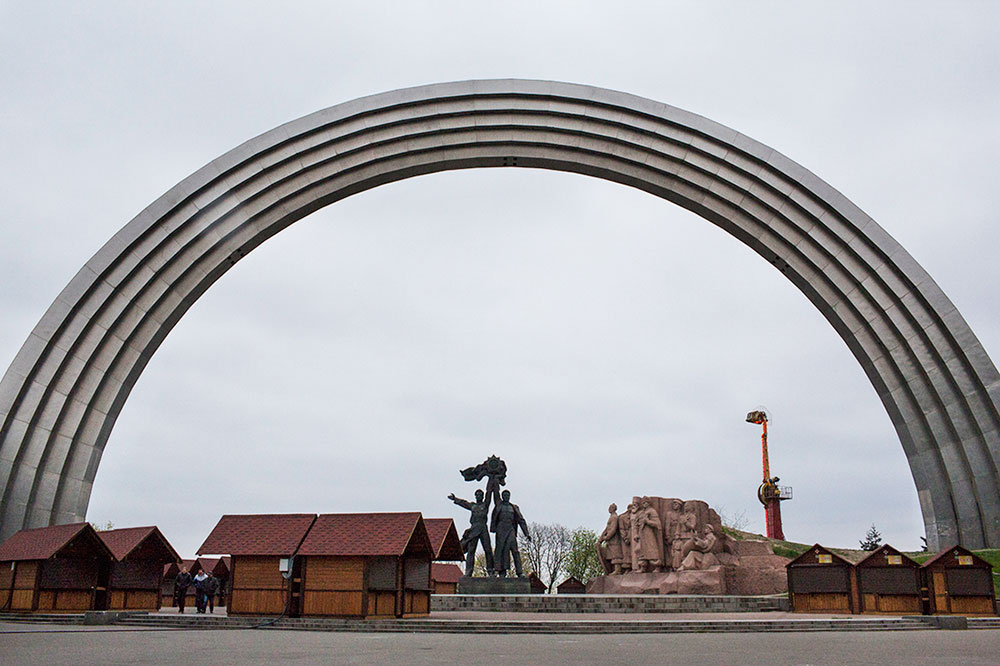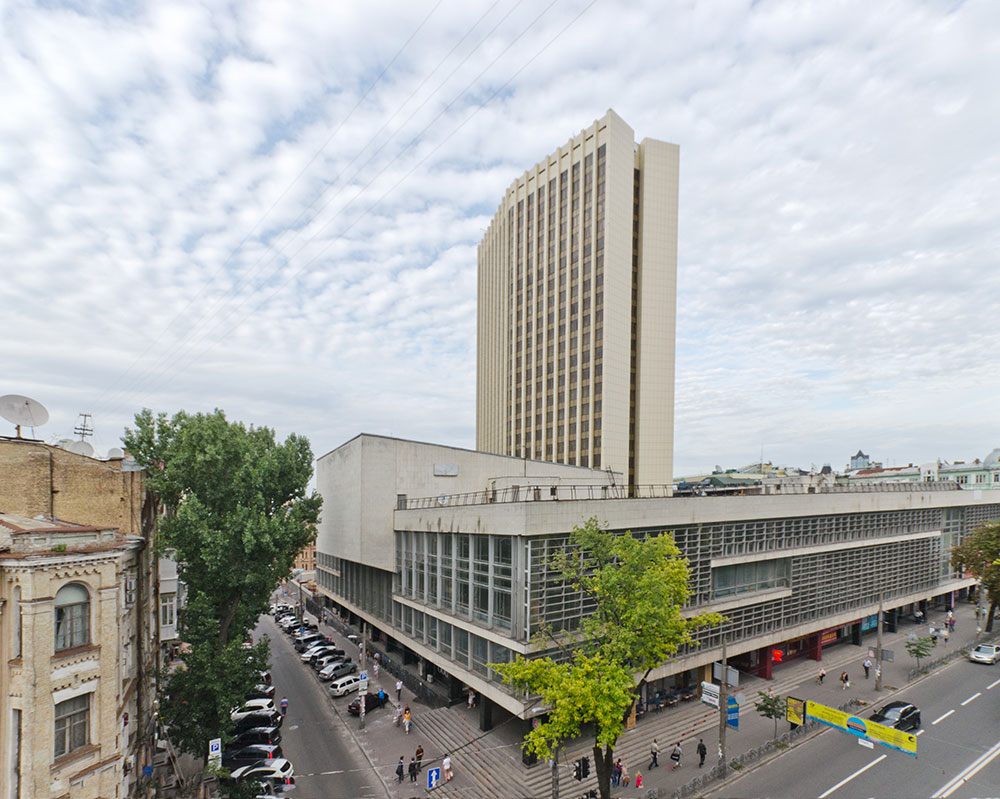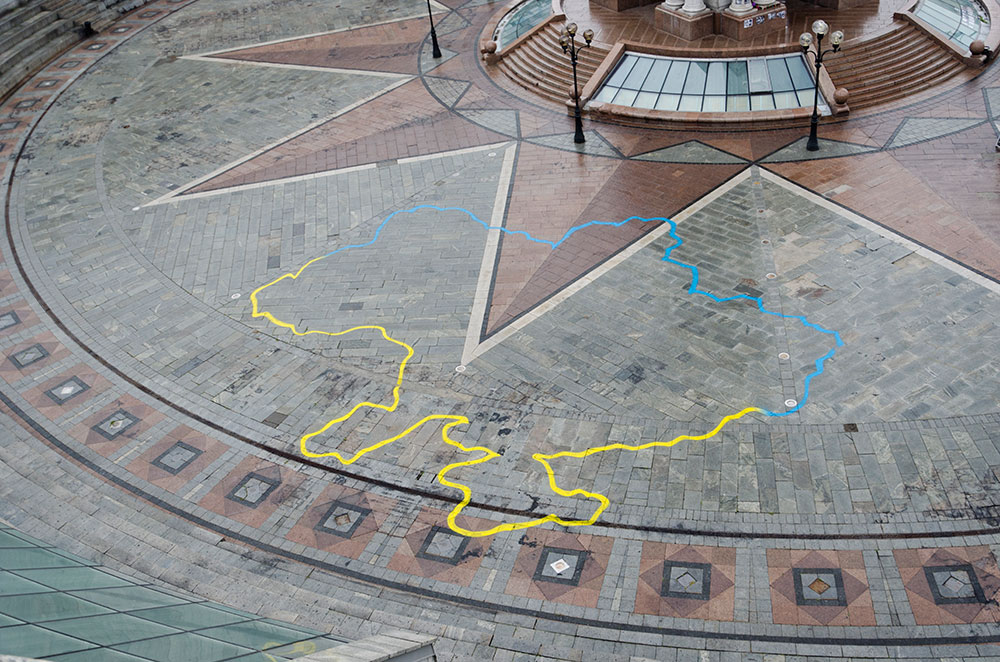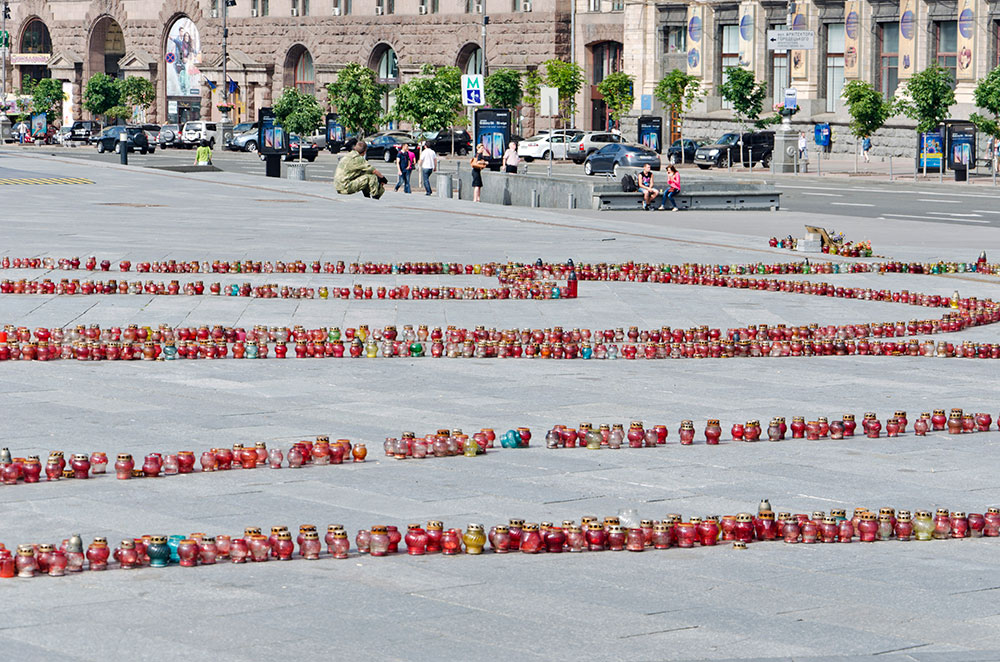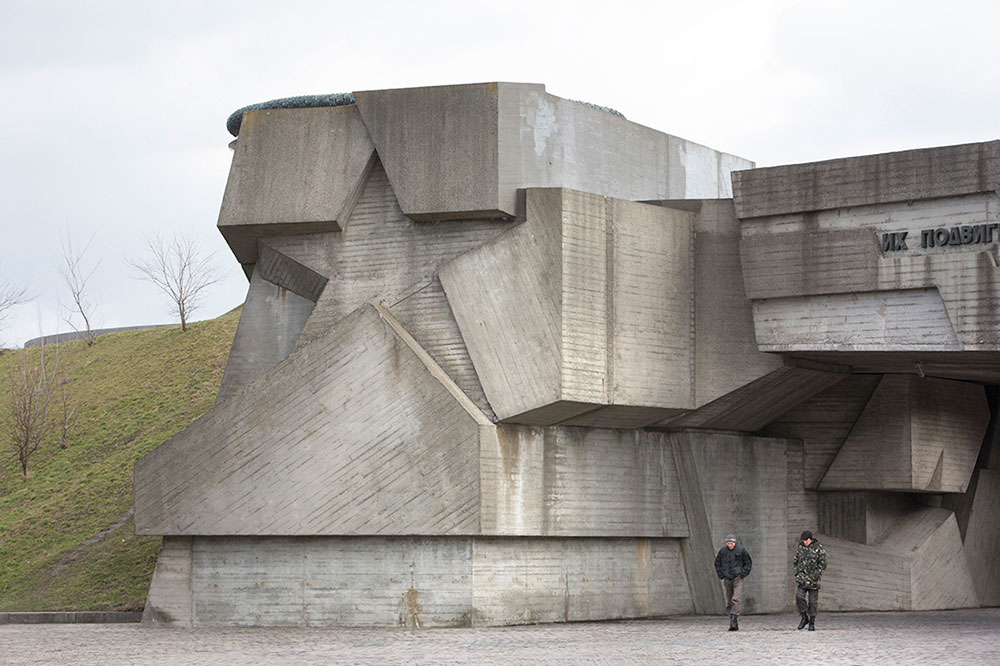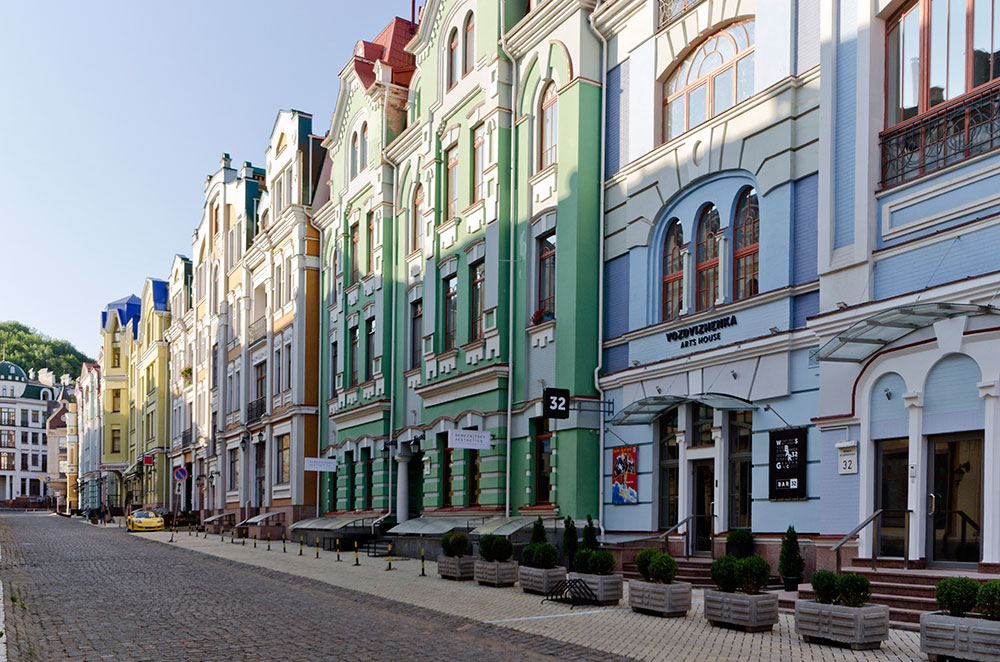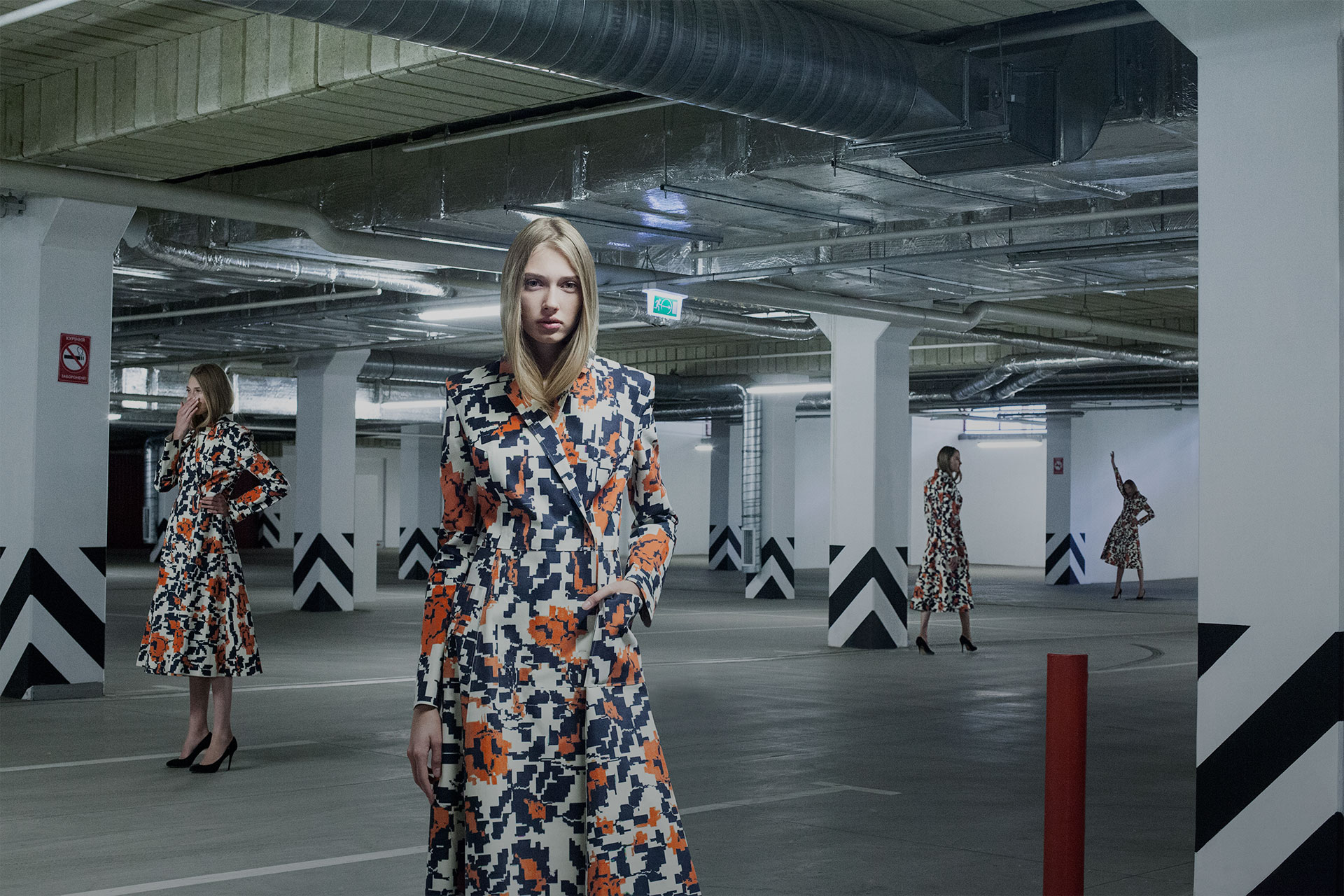The long view: should Kiev erase its Soviet past or learn to live with history, asks Owen Hatherley
Should Kiev erase its Soviet past or learn to live with history, asks Owen Hatherley
The city itself is the best school, leading you through its grand spaces, housing estates, ex-industrial wastes and “aspirational” enclaves
Lvivska Square is a small green space in the centre of Kiev. On one side of it are some worn art nouveau apartments, from the Ukrainian capital’s turn-of-the-century incarnation as a Tsarist boomtown, and a branch of the Austrian supermarket Billa. The three sides that are more dominant are Soviet, and modernist. There’s an ambitious neo-Constructivist building of the 1970s, featuring a series of allegorical women holding buildings and art materials, decorated to the ground floor with multicoloured tiles. This is the House of Artists.
Facing that is an edifice that has been left unfinished since the early 1990s, whose brick, steel and concrete are caked in dirt and graffiti. This was to be the Kiev Theatre Institute, and includes an entrance to a built, but never opened, Metro station below. Opposite that is a high-rise office block on a convex plan — the House of Trade.
Below it is a three-storey block with large plate-glass windows and marble cladding, with walkways leading to the street. Inside, it’s what Americans would call a “ghost mall” — a ground floor features a Stolovaya and a handful of shops selling various kinds of tat, but the escalators are permanently switched off. They’re lined in the same burnished brown artificial material that you find in the Kiev Metro. If you choose to take the stairs, every level features pop-Mondrian abstract stained glass windows, a different colour scheme for each level. On levels two and three, you come to the main venue for the Kiev art biennial of 2015.
Now, Kiev has the sort of prestigious, wealthy, oligarch-funded venues where you would expect such an event to be held, and indeed which have held biennials here before — Arsenal, a large space in a neoclassical Tsarist barracks, or the Pinchuk Art Centre, a typical oligarch’s gallery that specialises in contemporary art. The reason why it’s taking place mainly in a disused, if architecturally intriguing Brezhnev-era shopping mall and 15 other motley venues is the fact that the event had no major source of state or private funding. So the organisers, the Visual Culture Research Centre, a left-leaning group formerly asssociated with (until expelled from) the Kyiv-Mohyla Academy, improvised, with the actual curation provided by Austrians Georg Schöllhammer and Hedwig Saxenhuber.
The result is the School of Kyiv, where essentially the city itself becomes the object of the biennial. A series of “schools” (on “image and evidence”, “the displaced”, “realism”, “abducted Europe”, and “landscape”, in which — full disclosure — the present writer took part) take place around the city, with a bizarrely eclectic programme including figures of the neo-conservative right and others on the Marxist left, though seldom at the same time. But the city itself, and the route through it that the venues provide, is the best school, leading you through its grand spaces, housing estates, ex-industrial wastes and “aspirational” enclaves, to institutions where an A4 piece of paper with the biennial’s logo (or not) indicates its often seemingly reluctant participation.
In the House of Clothes, the works you find within the clean, clear lines and falling masonry are an interesting ragbag. Some are fairly typical biennial fare, and some deal with the cycle of revolution and war that has gripped the city since the uprising against Viktor Yanukovych and the resultant Russian incursions. Of these, some, such as Yuri Lieberman’s Odessa — Fragment 205, a film on the different sides taken by the city’s ageing ex-dissident punks and avant-garde artists when the city was forced, for the first time, to choose a “Ukrainian” or “Russian” identity, are subtle and moving. Others, such as a cartoonish heroic painting of Cossack-coiffed thugs pulling down the Lenin statue in Kharkiv, are not.
Many more reference the “Russian avant-garde”, to which Kiev has a legitimate claim, with parodic reproductions of work by Kiev-born Kasimir Malevich; the spectre of “de-communisation”, and what it might mean for the city’s iconography, is never far — improving quotes from Lenin still lurk on walls near the toilets. Beneath the gallery, on one day the Stolovaya holds in the evening a meeting of the Ukrainian-Japanese society, and on another, a cross-bearing procession marches ominously by. Neither group, you suspect, is aware of what’s happening above.
The giant Lenin head that looked over Teatralna station has been replaced with a naif painting of the Kiev Opera House
It is a long walk from here to the Kiev Metro, but that network gives a good indication of the state of Kiev and what decommunisation (the process of removing communist and Soviet symbols after they were outlawed earlier this year) might mean. The Metro is, unusually for an ex-Soviet country, overwhelmed by adverts, products either of “wild” capitalism — the tatty ads for jobs and flats sellotaped to the inside of the carriages — or of much bigger business.
At Maidan Nezalezhnosti, the beautiful upturned marble columns are obscured top-to-bottom by ads for Igor Kolomoisky’s Privat Bank, and at Tolstoy Square, by ads for Samsung. Video screens play ads from above, projectors project ads onto the walls. It’s a different kind of desecration to that called for by decommunisation, which has happened here in fragments.
The giant Lenin head that looked over Teatralna station has been replaced with a naif painting of the Kiev Opera House, and at Palats Ukraina, the stunning semi-abstract mosaic of a Red Guard from the January 1918 Bolshevik uprising at the Arsenal factory has been gingerly covered with a thin screen, as if the Metro’s staff are hoping that sooner or later, people will stop being so silly and they can take it off.
Elsewhere, though, decommunisation hasn’t happened at all – Vokzalna, the first station to be opened, in 1960, and one of the closest to the High Stalinist style with its bronze reliefs of Cossacks, Shevchenko, the Red Guards of 1918 and the victory of 1945, has been untouched, despite its reliefs of Lenin and its hammer and sickles. On the surface, too, the record is chaotic.
The monument to the workers’ rising at the Arsenal itself has been defaced and is clearly not longer for the world, yet a monument to the KGB survives at Lybidska Square, with its two giant granite heads of fearsome Chekists sprayed and scuffed, but too large to remove with anything other than explosives — not wise in such a densely packed area. It’s a reminder that decommunisation is a project which might actually be physically impossible to execute in full, which hopefully begs the question — if Soviet Ukraine can’t be wished away, what should be conserved, and what should be rejected?
If Soviet Ukraine can’t be wished away, what should be conserved, and what should be rejected?
There are a tiny handful of non-Soviet buildings serving as venues of the biennial, three or four pre-1917 and just one post-1991. Among the older structures is the National Museum of Art, a very handsome, purist neoclassical temple, just round the corner from Maidan Nezalezhnosti, the Stalin-era square which became the heart of the 2013-4 insurrection. Last time I was here, in March 2014, the Maidan encampment still endured, even after Yanukovych’s flight, with the piles ot tyres, the barricades, and the tired men in fatigues still all in their places.
Now all is cleared except the photos of the dead left by ordinary people, and the propaganda billboards added by the city government. Inside the Museum, William Kentridge was given the run of its remarkable collection of Soviet Ukrainian avant-garde painting, and selected two cycles by Anatoly Petrytskiy. One, 19 Ukrainian Intellectuals, consists of vivacious, imaginative, colourful sketches of the leaders of the Ukrainian Renaissance of the 1920s, when the Bolsheviks expressly promoted Ukrainian culture and language.
Next to these, pithy panels inform you who was purged, who informed, and who managed to avoid either. The other cycle is Petrytskiy’s drawings of Ukrainian villages after their liberation from the Nazis in 1943 and 1944, a dreamlike picture of a real, lived hell. These rather overshadow Kentridge’s own films in between, which provide a commentary on the revolution, the avant-garde and the purges through animation and montage clips.
The most explicit engagement with recent history comes in Nikita Kadan’s installations in the National History Museum, a dour 1940s Stalinist temple dressed in the Brezhnev era with integral reliefs, tapestries and stained glass narrating from the Ancient Greek colonies of Crimea through Kievan Rus to the revolution. Past an exhibit on Ukrainian “warriors” (the fascist Ukrainska Povstanska Armia and the Red Army placed on the same level, a stupid but not atypical conflation) and panels informing visitors why Ukraine should join NATO, Kadan’s installation consists of fragments of shells fired in eastern Ukraine during the recent war, suspended from the ceiling.
On the middle level of the Museum, on the floor of post-revolutionary history, Kadan has two metal frames filled with loaded objects — one consisting of objects from the Museum’s collection, such as statuettes of miners from Donbass, maquettes of blast furnaces and souvenirs from Crimea, next to a similar frame full of objects from the war, whether from the “separatist” or “patriotic” side, or those from neither, such as a battered sign from the destroyed Donetsk airport. It avoids any kind of commentary or heroisation, but it leads to a reconstructed tent from the Maidan encampment, and the new narrative of Ukrainian History, in which 2004 and 2014 are the new, unquestionable official story. Kadan’s attempt at neutrality and sensitivity is almost battered into submission by different eras of jingoism.
The contrasts the routes through the city create cannot but inculcate nostalgia for Soviet Kiev, because the contemporary built environment is an increasingly desperate vision of extreme inequality
Perhaps typically, much of the “school” takes place in industrial spaces, but there’s not much in the way of post-industrial chic in most of these. A clever series of Isotype tapestries on Ukraine’s disastrous economy and its exploitative trade links, by Andreas Siekmann, hang in the National Architecture Library, a neat modern building converted from a former canteen for printworkers. It is surrounded by the fragments of printworks and the former Bolshevik Factory, a gigantic engineering works which originally gave its name to the sparky Thaw-era Metro station, renamed in the 90s after the district, Shuliavska.
The machine sheds are looked over by clusters of luxury flats, on a gigantic scale, and the Economic and Financial University, whose neoclassical pediment features so-far-unvandalised stars, hammers and sickles. It stands next to a tank on a cantilevered plinth, and alongside are stelae of the “Hero Cities” of the “Great Patriotic War” (as it is no longer officially called in Ukraine), showing the monuments in each city to said heroism.
Of the many stelae here, of cities across Belarus, Ukraine and western Russia, only two, Moscow and Leningrad, have been vandalised. Graffiti and stickers show plucky Ukrainians beating up “Moskals”. It’s all a bit like writing “Down with Hitler!” over a picture of Bismarck.
One Soviet figure is, it seems, still likely to keep his name on streets and buildings — the great director Oleksandr Dovzhenko, whose films treated now deeply controversial matters such as the 1918 Arsenal Rising (in Arsenal) or the collectivisation of agriculture (in Earth) in a celebratory, albeit poetic and allusive way. The National Oleksandr Dovzhenko Centre occupies the eight storeys of a 70s film processing factory. Like the biennial itself, it’s an ambitious operation clearly working to a minuscule budget, aiming to become Kiev’s cinematheque, but so far only partly able to make the space viable for public visits, with pipes and gantries from its original incarnation lurching through the concrete floors and asbestos roofs.
The first and eighth floors are the Centre’s contribution to the School of Kyiv, showing a huge selection of films, most interestingly the educational films of the 1960s-80s documentary filmmaker Felix Sobolev, which present some shocking, haunting investigations into autosuggestion, hypnotism and mental adaptation. They’re instructively placed next to works on capitalist indoctrination by Harun Farocki on the eighth floor, where you get a good view of peripheral Kiev, with Soviet apartment blocks crowded out by adverts and the spreading masses of post-Soviet “luxury flats”.
The small offices of the Visual Culture Research Centre itself occupy one floor of a reclad light industrial building, in a post-industrial zone clearly in the process of being eaten up by high-rise infill flats, marked by billboards for the local elections — 15 or so oligarch-backed parties of the Right jostling for position. It showcases the part of the school on “the displaced”, with films on the migrant crisis in Europe, a useful corrective perhaps to the utopian image of the EU held by “Euromaidan”.
From the Visual Culture Research Centre, the 1960s trams lead to Kontraktova Square, an enclave of students shuffling around a diverse collection of very high quality and wholly non-bombastic architecture of every era — Byzantine churches from Kievan Rus, 17th century baroque, Petersburgian classicism, post-revolutionary Constructivism (like the Zhovten Cinema, just reopened after an arson attack by the highly active local far-Right), 70s Expressionism. It has long been seen as the natural place for Kiev’s creative class to come to the fore and create a hipster district of bars, galleries and start-ups. In the centre of the square is Hostinny Dvir, an old trading hall gutted by developers after a long battle to turn it into a luxury mall.
They lost, beaten by a “Right to the City” campaign, but the shell remains empty. Just round the corner from here, though, is a space which is an example of “creative class” urbanism of the most surreal and unexpected sort.
The nationalist purging of any traces of socialism from the landscape is a fool’s errand at best, gross historical revisionism at worst
It’s evidently not the intention of the organisers in any way, but the contrasts the routes through the city create cannot but inculcate nostalgia for Soviet Kiev, if nothing else because the contemporary built environment, with its overbearing infill towers marketed to the affluent, and its clusters of kiosks crowded around almost every public space, is an increasingly desperate vision of extreme inequality. There is one really new space used by the School of Kyiv, and it is instructive indeed.
That’s the Vozdvyzhenka Art House, one of several rather luxurious art spaces in Vozdvyzhenka, an entirely new district of “art nouveau-style” apartments, just off Kontraktova square. Their concrete frames are decorated with thin, shiny and multicoloured approximations of the fin de siecle city – which, in its “real” form, is more often rotting and dilapidated. Inhabited, it seems, mainly by enormous cars and construction workers, it is unnerving but remarkably complete, especially by Kiev’s chaotic standards.
The Art House’s contribution to the biennial is an exhibit by Pedro G Romero on Les Checas, the abstract “psycho-technical” torture chambers developed by Spanish artists and NKVD advisers, and used on Francoist prisoners near the end of the Spanish Civil War.
Modern art and Stalinism — even the Spanish Republic was evil too, you know, full of bloodthirsty Communists and Anarchists who tortured priests — meet here in an oligarch’s fantasy of the wonderful world before the revolution of 1917, and in a city where 2014’s popular revolution against a grotesquely wealthy elite has become a nationalist purging of any traces of socialism from the landscape.
Here, when most of the landscape was built under communism, it’s a fool’s errand at best, gross historical revisionism at worst. The School of Kyiv stands, for the most part, clearly against this kind of simple-mindedness, and provides those who choose to take its lessons a series of contradictory classes in one of the most fascinating, beautiful and conflicted cities in Europe. Lessons, not answers.
Text: Owen Hatherley
Image: Ryan Koopmans, Oleksandr Burlaka, Egor Rogalev (from the Synchronicity series)
Date: November 2015
